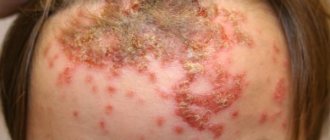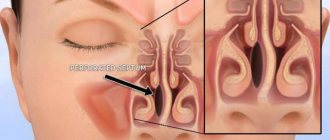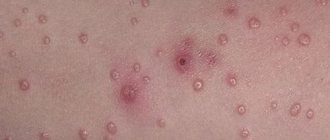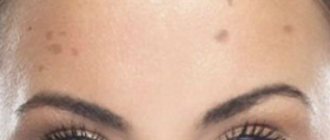Removal of facial and scalp tumors
Various neoplasms appear in humans at birth or throughout life.
Some of them are benign and only cause aesthetic inconvenience. Others are malignant in nature and can provoke the development of cancer. In our medical center, removal of tumors of the face and scalp is carried out by doctors of the highest category with many years of experience. Surgeons use modern surgical methods, including laser surgery. Patients have the opportunity in a short time, without fear of negative consequences, to eliminate a cosmetic defect on the face and head.
Description
Indications for tumor removal
In our clinic, doctors successfully perform operations to eliminate various tumors. Surgical intervention allows you to combat the following pathologies:
- moles are accumulations of melanin that have a flat or slightly voluminous shape and vary in size;
- Lipomas are benign accumulations of fatty tissue under the skin;
- keratomas - scaly growths on the skin that occur due to exposure to sunlight;
- atheroma - appears on the scalp due to blockage of the sebaceous gland;
- fibroma is a pathological accumulation of connective tissue on the skin and mucous membranes, round or oval in shape;
- xanthelasma - is benign in nature, appears as pale yellow plaques on the skin.
Malignant neoplasms include warts and their subtypes that arise due to HPV infection.
Indications for surgical removal of tumors are cosmetic or medical in nature. In the first case, the problem does not threaten the health and life of the patient. Treatment is carried out to eliminate cosmetic defects.
Medical indications for removal are:
- risk of degeneration into a malignant form;
- viral nature of formations;
- location of the pathology in places of permanent injury.
Before removing tumors of the scalp and face, our patients are required to undergo a preliminary examination. With its help, the doctor will determine the nature of the problem and select the appropriate treatment tactics.
Possible contraindications
There are a number of diseases and conditions of the human body in which surgical manipulation of the skin and mucous membranes is contraindicated. These include:
- hypertensive crisis;
- acute respiratory diseases;
- herpes in the acute stage;
- some types of malignant neoplasms;
- severe allergic reaction.
Doctors at our medical center, if they detect absolute or relative contraindications in a patient, will select a different tactic to combat the pathology.
Laser treatment of tumors
Exposure to pathological areas with a focused laser beam is a modern technique that does not cause pain to the patient. In our clinic, a semiconductor or CO2 laser is used to remove tumors on the face. This method has a number of advantages over conservative surgical methods:
- nearby tissues are not damaged;
- no bleeding;
- absence of pain;
- therapeutic efficacy;
- there is no need to stay in the inpatient department of the clinic.
Using a laser beam, you can remove almost all tumors - the device has three operating modes. Find out more about the terms of service and its cost. Contact the clinic doctor using the contacts listed on the website.
Varieties
A wart on the head can be:
- simple is a keratinized papule, the diameter of which does not exceed 7 mm. As soon as a simple papilloma appears on the skin, it is flesh-colored, but over time its color changes to brown or gray. Usually, daughter growths grow next to such a formation. Should such a papilloma be removed or not? Definitely yes, since after frequent injury it can not only grow into a large wart, but also degenerate into a malignant tumor;
- flat papillomas have a smooth, contoured surface, can rise above the skin no more than 2 mm and be up to 5 mm in diameter. In appearance, such warts resemble flat nodules; they most often appear on the skin of the face. The color of the wart can be pink, flesh-colored or brown. The shape of such formations is round, but when several papillomas merge, the result is irregular;
- condylomas are a papillary growth on a stalk of soft consistency. The color of such formations is pink, reddish or flesh-colored. They most often appear on the eyelids and near the lips, and can also grow under the hair. If such a wart is not treated, it will become quite large and cause pain and visual discomfort;
- Keratomas are warts that appear only in older people. They can reach 3 centimeters in size. In appearance, keratomas resemble loose plaques, the surface of which is covered with sebaceous and horny masses. They are usually dark in color and may itch. Such warts appear on the head under the hair or on the temples, but can also affect other parts of the head.
The first three types of papillomas under unfavorable conditions, for example, with frequent trauma, can degenerate into a malignant tumor.
Neoplasms on the scalp
Neoplasms (papillomas, atheromas, wen) that appear on the scalp should be a reason for you to immediately consult a doctor. Why are they dangerous? It is important to understand that any benign formations (nevi, keratomas, papillomas) located on the scalp are very often injured as a result of washing the hair, using a hair dryer, hair dyes, combs, or wearing a tight hat. And trauma, as is known, can cause a benign tumor to develop into a malignant one .
Atheromas (sebaceous gland cysts) are benign formations.
In addition to an extremely unaesthetic appearance, atheromas can fester, hurt, and cause fever and swelling. A suppurated arethroma can break out on its own. This leads to the need for urgent surgery - emergency surgery to remove atheroma on the head. Therefore, in this case, you also need to consult a doctor as soon as possible for planned surgical removal, which is often more expedient and less traumatic.
Etiology of warts on the head
In addition to the papilloma virus already mentioned above, which is detected in 90% of people during PCR diagnostics, the following triggers can provoke the formation of warts on the head:
- Decreased immune system of the body;
- Stress, overwork, nervous-emotional tension;
- Poor nutrition, vitamin deficiency;
- Hormonal imbalance;
- Mechanical damage to the skin of the scalp;
- Severe infectious or inflammatory process.
Quite often, the appearance of primary (maternal) warts on the head is observed in children, due to the imperfection of the child’s immune system, as well as in pregnant women whose bodies are subjected to serious hormonal stress.
Features of treatment of scalp tumors at Neo Skin Medical Center
First of all, the patient receives advice from a qualified dermatologist regarding his problem. The doctor listens carefully to the patient’s complaints, asks questions, and conducts a direct examination. If it is necessary to clarify the diagnosis, preoperative treatment may be prescribed. Depending on the feasibility, surgical treatment will be performed by an experienced surgeon.
Communication with a doctor takes place individually, without the presence of strangers, in compliance with strict confidentiality. Surgical treatment occurs under local anesthesia (drugs are selected individually).
When suturing a wound, only the highest quality materials are used.
Doctors at the Neo Skin center pay great attention to good cosmetic results.
- When removing tumors, only cosmetic (intradermal) sutures are used, which protects against the formation of rough scars.
- The area where the operation is performed is not trimmed (shaved), as happens in ordinary public hospitals, which very often causes patients to delay the moment of seeing a doctor.
- The postoperative period proceeds unnoticed by others. The patient does not drop out of everyday life.
After surgical treatment, the attending physician needs no more than three to four visits in a two-week period for a follow-up examination.
Treatment effectiveness
There are no relapses at the site of radical removal of benign formations of the skin and subcutaneous fat (the exception is lipomas, which recur in 5% of cases). This way you will get rid of the cosmetic effect and take care of your health. Unfortunately, there are a large number of growths or formations on the human body, these include not only formations on the head, but also tumors on the genitals.
Contact the Neo Skin medical center and get an effective solution to the problem of neoplasms of the scalp!
Symptoms and diagnosis
- More often than others, flat warts of round or irregular shape appear on the head, their surface is smooth, and their borders are easily defined. There is no skin pattern on the surface of such formations.
- Some warts on the head can look like cauliflower; they are the most dangerous because they are easily injured.
To correctly determine the type of papilloma, the dermatologist prescribes a number of studies:
- dermatoscopy;
- histological examination of skin formation tissues;
- PCR study.
If after the examination the nature of the neoplasm remains unclear, a biopsy may be prescribed.
What is it and why did it appear?
The scalp, with the exception of thick hair, is essentially not much different from neighboring areas of the body. It is also subject to pathological changes, among which proliferative processes occupy a special place. There are a number of additional factors that increase the risk of their development:
- Injury when combing or shaving.
- Exposure to chemicals (during painting, curling).
- Excessive insolation.
The most common benign growths include warts and papillomas. These are epithelial growths caused by papillomavirus. Typically, the pathogen penetrates through damaged skin in the presence of abrasions, scratches, and abrasions. Infection can occur in several ways:
- Contact household (use of shared towels, combs).
- Vertical (from mother to child during childbirth).
- Autoinoculation (during shaving).
There are more than 100 types of human papillomaviruses (HPV). Some of them do not manifest themselves in any way, others lead to the formation of warts, but there are also those that are dangerous for the development of precancerous and oncological processes. In addition to skin injury, predisposing factors are:
- Reduced immunological reactivity.
- Infectious diseases.
- Psycho-emotional stress.
- Vitamin deficiencies.
- Increased sweating.
Types of skin tumors
Papilloma is a soft tissue formation of a papillary (thread-like) shape that is flesh-colored or brownish in color. As they grow, they can take on the appearance of a growth with a bumpy surface, similar to cauliflower. Usually, papillomas do not cause discomfort (except for aesthetic reasons), but if injured they can become inflamed or bleed.
Warts are defined as spherical or flat nodules with a keratinized, uneven surface. They have a dense structure, dry, painless. Sometimes warts merge into large plaques. Like papillomas, such growths do not cause discomfort, but with permanent damage they require increased attention.
Older people are more likely to develop keratoacanthoma, a benign tumor that originates from hair follicles. Such formations are round in shape, dense, and flesh-colored. Sometimes keratoacanthoma shows rapid growth, sometimes reaching 2–3 cm in diameter.
The most serious in terms of prognosis is melanoma - a malignant tumor of pigment cells with a high degree of aggressiveness. It looks like a small dark brown plaque with a rough surface and indistinct edges. The danger of melanoma lies in the rapid appearance of local screenings and distant metastases.
Another reason to visit an oncologist is basal cell carcinoma. This is a type of skin cancer that develops from cells of the basal layer of the epithelium. Such suspicion may arise when a flesh-colored or reddish nodule with a flaky or crusty surface is identified. After the latter falls off, the ulcerative defect is exposed. The tumor does not metastasize.
A red, bumpy formation under hair with a soft consistency usually turns out to be a hemangioma. This is a benign tumor that forms in the prenatal period due to a defect in the development of blood vessels. It rises above the surface of the skin, and when pressed, it collapses. When damaged, the hemangioma bleeds easily.
Not only papillomas and warts, but also other neoplasms, including malignant ones, can appear on the scalp.
Why are warts on the head dangerous?
Both simple (vulgar) neoplasms and warts associated with age-related keratotic changes can form on the head. The latter cannot be considered true warts, since they are not viral in nature and usually appear as seborrheic structures. As for ordinary warts on the head, they have a dense consistency and a different color shade - from yellowish to brown.
Despite the fact that a wart on the head in the hair always has a benign nature of tissue growth, this localization zone is considered quite dangerous. This is due to the high risk of mechanical damage to the neoplasm during combing the hair. In this case, severe bleeding may occur, which is a consequence of traumatic damage to the vessels and capillaries feeding the body of the growth, which always actively grow around the warts. In addition, there is a high risk of subsequent infection and inflammatory reaction.
Some types of warts are not so harmless, and can be regarded by doctors as a precancerous condition, so finding a wart under your hair on your head is a good reason to consult a specialist.
Treatment of pathology
Based on the reason for the development of growths and their nature, various methods of therapeutic correction can be used. The doctor will tell you which of them is best to use in a particular case.
Methods for removing papillomas
Papillomas are recommended to be removed in several situations: the presence of a cosmetic defect, frequent trauma, the patient’s desire. Typically, minimally invasive methods are used for this:
- Cryotherapy (liquid nitrogen).
- Electrocoagulation.
- Laser destruction.
Such methods have a number of advantages - speed, low risk of side effects, quick recovery. If the growths are large and fused, instrumental excision (with a scalpel) may be required to remove them.
An alternative to radical removal using minimally invasive and surgical methods may be the use of local medications with destructive and cytostatic properties. These include:
- Podophyllin (Vartek, Condilin).
- Imiquimod (Keravort, Aldara).
- Synecatechin (Veregen).
- Solcoderm.
- 5-fluorouracil.
At the same time, you should undergo a course of treatment for HPV infection. Usually drugs with antiviral and immunomodulatory properties are prescribed: interferon, Panavir, Isoprinosine, Immunomax. Vitamins are also used to increase the body's nonspecific resistance.
To remove papillomas on the scalp, minimally invasive, surgical and medicinal methods are used.
What to do with other formations?
The tactics of treating tumors of the scalp boils down to removing the formation itself and preventing metastasis (in case of malignant processes). The main method is surgical excision within healthy tissues or extended - with nearby lymph nodes.
For some tumors (keratoacanthoma, basal cell carcinoma, angiomas), laser therapy and cryodestruction are in demand. Late stages of melanoma are treated with chemotherapy, immunotherapy and radiotherapy. Gene therapy for the tumor is at the research stage.
Neoplasms on the scalp
Neoplasms (papillomas, atheromas, wen) that appear on the scalp should be a reason for you to immediately consult a doctor. Why are they dangerous? It is important to understand that any benign formations (nevi, keratomas, papillomas) located on the scalp are very often injured as a result of washing the hair, using a hair dryer, hair dyes, combs, or wearing a tight hat. And trauma, as is known, can cause a benign tumor to develop into a malignant one .
Atheromas (sebaceous gland cysts) are benign formations. In addition to an extremely unaesthetic appearance, atheromas can fester, hurt, and cause fever and swelling. A suppurated arethroma can break out on its own. This leads to the need for urgent surgery - emergency surgery to remove atheroma on the head. Therefore, in this case, you also need to consult a doctor as soon as possible for planned surgical removal, which is often more expedient and less traumatic.
Formations such as lipomas do not develop into a malignant tumor, but they are characterized by active growth. Thus, over time, a pronounced cosmetic defect is formed. Therefore, you should also not delay the removal of lipomas on your head.
Remember , self-medication of such neoplasms is EXTREMELY contraindicated, as it can lead to the spread of the process.
If you suspect the appearance of neoplasms of the skin or subcutaneous fat of the scalp, you should immediately consult a doctor!
At the Neo Skin medical center you can receive a full range of services for the diagnosis and treatment of tumors of the scalp.
The center provides surgical treatment of tumor diseases of the skin and subcutaneous tissue of the scalp (benign and malignant tumors of the skin), atheromas (sebaceous gland cyst), lipomas (benign tumor of the subcutaneous fatty tissue), etc.
Causes
The main cause of warts is called papillomavirus, which can enter the human body in the following ways:
- through contact with the things of a virus carrier: dishes, shared shoes in a bathhouse, a towel, etc.;
- through wounds and other skin damage;
- in public places, transport: handles of grocery baskets in a store, handrails on a bus, etc.
Once in the subepithelial layer of the dermis, the papilloma virus remains there for a long time.
The disease will begin to manifest itself when the immune system weakens again, and then warts will appear on the body.
Papillomas will appear on the head if the following factors occur:
- abundant sebum secretion on the scalp;
- bad habits;
- sweating on the skin in the same area;
- regular stress;
- Thick hair;
- gastrointestinal diseases;
- past infectious pathologies;
- long-term use of certain medications.
Having appeared in the hair, papilloma may not be noticeable until it begins to grow rapidly or daughter growths appear.
Features of treatment of scalp tumors at Neo Skin Medical Center
First of all, the patient receives advice from a qualified dermatologist regarding his problem. The doctor listens carefully to the patient’s complaints, asks questions, and conducts a direct examination. If it is necessary to clarify the diagnosis, preoperative treatment may be prescribed. Depending on the feasibility, surgical treatment will be performed by an experienced surgeon.
Communication with a doctor takes place individually, without the presence of strangers, in compliance with strict confidentiality. Surgical treatment occurs under local anesthesia (drugs are selected individually).
When suturing a wound, only the highest quality materials are used.
Doctors at the Neo Skin center pay great attention to good cosmetic results.
- When removing tumors, only cosmetic (intradermal) sutures are used, which protects against the formation of rough scars.
- The area where the operation is performed is not trimmed (shaved), as happens in ordinary public hospitals, which very often causes patients to delay the moment of seeing a doctor.
- The postoperative period proceeds unnoticed by others. The patient does not drop out of everyday life.
After surgical treatment, the attending physician needs no more than three to four visits in a two-week period for a follow-up examination.
Treatment effectiveness
There are no relapses at the site of radical removal of benign formations of the skin and subcutaneous fat (the exception is lipomas, which recur in 5% of cases). This way you will get rid of the cosmetic effect and take care of your health. Unfortunately, there are a large number of growths or formations on the human body, these include not only formations on the head, but also tumors on the genitals.
Contact the Neo Skin medical center and get an effective solution to the problem of neoplasms of the scalp!
Why is a cyst on the head dangerous?
When atheroma occurs, it is not always clear whether it is dangerous and how it can harm your body. Initially, an epidermal cyst is not a cancerous formation, i.e. benign and harmless. Unfortunately, over time, atheroma can cause infection or inflammation, which can progress to a chronic stage. In the future, this leads patients to complications, so this is where the danger of atheroma lies - in the consequences.
Many people try to diagnose themselves, without the help of a doctor, but as a result they confuse what kind of formation has appeared - a lipoma or an atheroma, or maybe even a hemangioma. But, by comparison, a lipoma is, although benign, a tumor of connective tissue, a hemangioma is also a tumor, but consisting of blood vessels, and atheroma is just a tumor-like neoplasm.
To know exactly the nature of the tumor and its danger to your health, be sure to contact a medical institution for a qualified diagnosis and help, do not resort to self-medication and try to get rid of the tumors as soon as possible so that they do not develop into formations dangerous to health!
The harm is that during the inflammatory period, it is not recommended to remove the cyst - first it is necessary to relieve the inflammation. Many patients go to the doctor when it is too late - the atheroma swells and ruptures, causing infection. Sometimes the consequences of atheroma are even less rosy - skin cancer, so contact a specialist in time.











